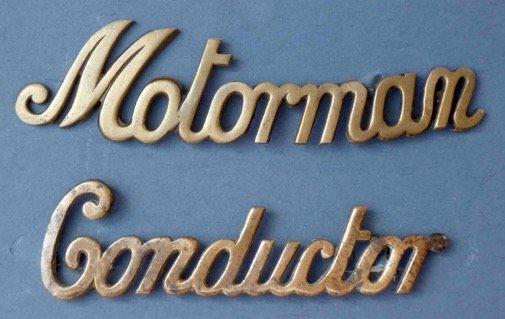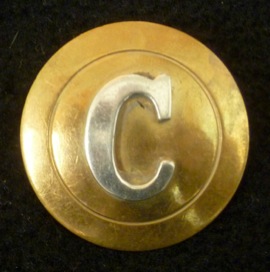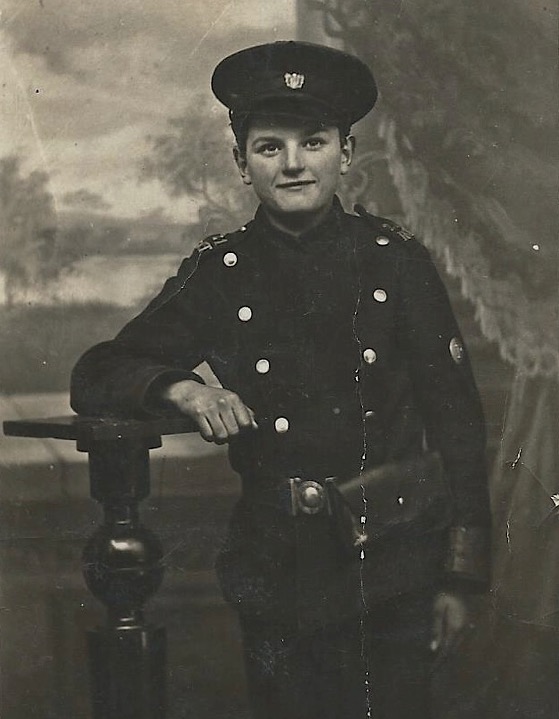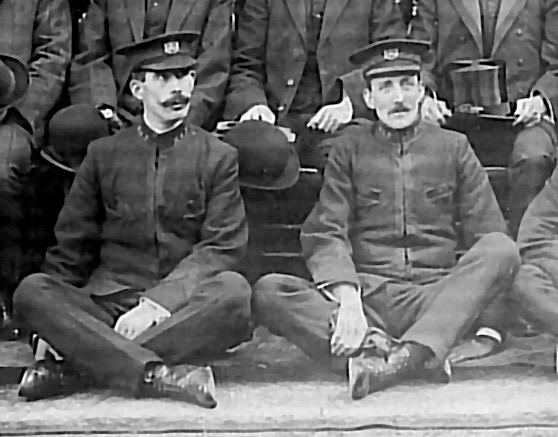Reading Corporation Tramways
Summary
Photographs of tramwaymen taken during the corporation horse tram era, i.e., between the take-over of the Reading Tramways Company in November 1901, through to the end of horse-drawn operations in July 1903, show them wearing single-breasted jackets with five buttons and lapels, and more often than not, long-double-breasted greatcoats with five pairs of buttons, and lapels. The lapels on the jackets appear to have carried some form of embroidered insignia, whilst the overcoat collars were apparently entirely plain. Headgear consisted of a rather squat kepi-style cap, which bore a prominent oval cap badge; the badge seems to have been of metal fretwork, though photographs are not of sufficient quality to state this with certainty.
Photographs taken during the corporation era show horsecar drivers and conductors wearing a round enamel licence (drivers, blue lettering on a white background; conductors, red lettering on a white enamel background). The licences continued to be worn in the electric era, but appear to have been fairly rapidly dispensed with, though they seemingly saw brief service once again during the Great War, when they were issued to female staff.
Following electrification, staff were issued with double-breasted, lancer-style tunics with five pairs of buttons (bearing a municipal device — see link) and stand-up collars; the latter carried individual 'R C T' metal initials on the bearer's left-hand side, and an employee number on the right-hand side; it is unclear whether the initial insignia were brass or nickel, though they were definitely brass from 1912 onwards. The jackets and trousers were of dark serge, with the latter having a red stripe down the sides. Caps were of the tensioned-crown peaked type; they bore script-lettering grade badges — either 'Motorman' or 'Conductor' — above which a municipal-device badge was worn. This badge took the form of a tall pointed oval, and comprised five heads, the central one wearing a crown, surrounded by the town motto 'ST COMMVNITATIS RADINGIE'.
Within a relatively short period, however, the employee number was moved from the right-hand collar to underneath the grade badge (on the cap), with both collars then carrying the system initials; the oval municipal-device badge was probably dropped from the cap at the same time to make room for the employee number. Motormen and conductors were also issued with long double-breasted greatcoats with five pairs of buttons, high, fold-over collars and epaulettes; once again, these garments appear to have been devoid of insignia.
Around 1912, the cap badges (script-lettering grade badge and employee number) were replaced by a new style of cap badge, which was broadly shield-shaped (see below), but surrounded by garlands, with a ribbon beneath containing 'BOROUGH OF READING'. The stand-up collars were now left plain (i.e., unadorned), whilst the employee number and system initials were worn one above the other on shoulder epaulettes. The grade was now denoted by a small round brass badge with a nickel letter mounted in the centre — 'C' for conductor or 'M' for motorman — these were worn on the upper left-hand sleeve of crewmen's jackets.
Very late in the tramway's life, at least some staff appear to have been issued with more modern double-breasted jackets with lapels, possibly bearing chrome insignia. Lightweight dust coats were occasionally worn during the summer months, and though issued to bus crews, they were never standard 'tramway' issue.
Good conduct was initially denoted by the addition of sergeant's stripes to the bearer's right-hand sleeve, and from around 1912 onwards, the addition of a brass star beneath the grade badge on the bearer's left-hand jacket arm.
Reading also employed parcels boys (and girls too apparently). They wore identical uniforms to tramcar staff, but with 'Tramways Parcels Express' on their caps (probably embroidered), and from around 1912 onwards, the standard 'shield, garland and ribbon' cap badge , along with a 'P' on their grade badge (worn on the left upper arm). They were also issued with sturdy belts that bore a message pouch (see below).
In the first two decades of operation, and possibly throughout the tramway's life, inspectors wore single-breasted jackets with hidden buttons (or more likely a hook and eye affair), edged in a finer material than the main jacket, with stand-up collars, and later on epaulettes. The collars carried 'R C T' initials on both sides (possibly embroidered), though with the introduction of epaulettes, these were replaced by municipal 'shield, garland and ribbon' badges, with the system initials moving to the epaulettes. The tensioned-crown peaked caps bore a large shield-shaped brass badge, comprising the municipal-device within a wreath, with a ribbon below containing the grade — 'Inspector' — in small letters. The cap badge was possibly changed to a simpler design at some point prior to the Second World War, though confirmatory photographic evidence is currently lacking; the badge was made in chrome, and comprised the municipal device with the grade — 'INSPECTOR' — below in voided block capitals (see below).
In common with many tramway operators, Reading Corporation Tramways employed female staff during the Great War to replace male staff lost to the armed services, initially as conductresses, though later on as motorwomen too. These ladies were issued with tailored, single-breasted jackets with five buttons, lapels, epaulettes, and a waist belt (also with buttons); a long matching skirt was also worn. Headwear was of the wide-crown peaked cap type; these caps carried the standard municipal 'shield, garland and ribbon' cap badge. The ladies were also provided with greatcoats, which appear to have been unmarked. Two ladies (at least) were elevated to the rank of inspector, and were issued with tailored jackets and skirts that differed markedly from those worn by the tramcar ladies; a shirt and tie was also worn, along with the standard cap and the larger cap badge worn by male inspectors.
My thanks go to John Whitehead and Derek Lucas for providing several excellent photos, as well as giving freely of their extensive knowledge.
For a pictorial history of the town's tramways, see: "Reading Tramways" by Edgar Jordan; Middleton Press (1996).
Images
Horse tram drivers and conductors
A driver and a conductor with Horsecar No 5 at the Oxford Rd terminus — photo undated, but certainly taken during the corporation years (November 1901 to July 1903). Both men have small round licences, almost certainly of the type depicted below; the driver is wearing a kepi-style cap with a prominent oval cap badge. Photo courtesy of the Tramways and Light Railway Society, with thanks to David Voice.
Reading tramway 'Conductor' and 'Driver' licences — red and blue lettering on white enamel. These were worn during the horse-tram era and briefly during the early electric period. With thanks to Greenslade Auctions.
The driver and conductor of Horsecar No 6 stand with their charge in Wokingham Rd — photo undated, but certainly taken during the corporation years. Once again, both men are wearing squat kepi-style caps and white licences. Photo courtesy of the Tramways and Light Railway Society, with thanks to David Voice.
A rather poor quality image, but one that shows a corporation driver and conductor in greatcoats with Horsecar No 8, possibly in the vicinity of the London Rd terminus — photo undated, but definitely taken during the corporation era. Photo courtesy of the Tramways and Light Railway Society, with thanks to David Voice.
Motormen and conductors
A studio portrait of a Reading Corporation Tramways conductor, Employee No 62 (holder of Licence No 92) — photo undated, but very likely taken around the time the new electric services were introduced (1903). Photo courtesy of the Stephen Howarth Collection.
An enlargement of the above photograph showing details of the cap and collar insignia. The cap badge incorporates the Reading shield with its five heads, along with the town motto.
A Reading municipal-device cap badge — nickel. This pattern of cap badge was almost certainly that worn during the early years of the electric system; however, it may have been brass rather than the nickel example shown here. Author's Collection.
Standard off-the-shelf script-lettering grade badges of the type used by Reading Corporation Tramways — brass. Author's Collection.
Another studio portrait, this time of two Reading motormen — photo undated, but probably taken in the mid-to-late Edwardian era. Although both men are wearing script-lettering 'Motorman' cap badges, the pointed oval cap badge seen in the earlier studio portrait appears to be absent. Another change is the removal of the employee number from the bearer's right-hand collar. Whilst many other photos from this period conclusively show the number being worn beneath the script-lettering grade badge, neither man depicted here has one; it may well be that both men were working their probationary periods, so were yet to have them formally issued. Photo courtesy of the Stephen Howarth Collection.
A conductor and a motorman pose with Tramcar No 28 on a service to Erleigh Rd — photo undated, but possibly late Edwardian given the exterior side destination board (these were relatively quickly replaced with interior roller blinds). The conductor's employee number (possibly 54) can clearly be seen beneath his script-lettering grade badge. Author's Collection.
A photograph taken to commemorate those staff attending the Church Parade on the 13th September 1908. Photo courtesy of John Whitehead.
An enlargement of the above photograph showing some of the conductors and motormen. One individual (2nd row, 2nd from right) has sergeant's stripes; these were awarded for good conduct (my thanks to John Whitehead for this information).
A conductor and a motorman pose with their Whitley-bound tramcar, possibly No 23 — photo undated, but probably taken shortly before the Great War. The grade badges had by this time been replaced by a small municipal 'shield, garland and ribbon' badge. The small round badges on each of their respective left jacket sleeves were grade designations, presumably introduced when the script-lettering cap badges were dispensed with. Author's Collection.
Reading Borough cap badge — brass, almost certainly the same pattern as worn by staff of Reading Corporation Tramways from around 1912 through to closure in 1939. Author's Collection.
Reading Corporation Tramways conductor's grade badge — nickel letter on brass. This was worn on the bearer's left sleeve, being introduced around 1912 and lasting up until closure in 1939. Author's Collection.
Reading Corporation Tramways motorman's grade badge — nickel letter on brass. This was worn on the bearer's left sleeve, being introduced around 1912 and lasting up until closure in 1939. Author's Collection.
Studio portrait of a Reading conductor — photo undated, but probably taken around the time of the Great War. The new style of grade badge, bearing a 'C', is clearly seen on the subject's left arm. Although not easy to see in this photo, the epaulettes actually carry the employee number and system initials, with the collars left plain (unadorned). Photo courtesy of the Stephen Howarth Collection.
Another studio portrait, this time of a Reading Corporation Tramways parcels boy, F. Cecil Harrison — photo taken between 1916 and 1918. Note the 'P' on the grade badge, as well as the message belt and pouch. Photo courtesy of Derek Lucas.
Reading Corporation Tramways staff at the Church Parade — photo undated, but probably taken shortly after the Great War. Photo courtesy of the Stephen Howarth Collection.
An enlargement of the above photograph revealing the epaulette badges to be 'R C T' initials accompanied by an employee number. All present appear to be wearing stars beneath the grade designation on their left arms, which denoted good conduct.
A conductor and a motorman with Tramcar No 18 — photo undated, but possibly taken in the 1920s or 1930s. Source unknown.
A motorman on the platform of Tramcar No 8 at the Oxford Rd terminus on 30th September 1937. Photo by W A Camwell, courtesy of the National Tramway Museum. 
Reading Borough cap badge — nickel. There is no evidence whatsoever that Reading Corporation Tramways ever used this material, though that does not mean that they did not. Given that it is not marked as 'tramway', it could equally well have been used by another department within the municipality, for example, Reading Borough Police. Author's Collection.
Senior staff
An enlargement of the 1908 staff photograph above showing two of the inspectors. The cap badge appears to take the form of a large shield, and is much larger and more elaborate than those worn by motormen and conductors. Photo courtesy of John Whitehead.
A staff photo taken in the yard at Mill Lane Depot in 1918. Photo courtesy of John Whitehead.
An enlargement of the above photograph showing, on the second row from the front, three male inspectors and two female inspectors — both sexes are wearing the larger cap badge seen in the 1908 photograph.
A Reading Corporation Transport inspector's cap badge — chrome. There is a suspicion that this pattern of cap badge was introduced shortly before the demise of the tramway in 1939, however, photographic confirmation is currently lacking. Author's Collection.
Female staff
A Reading Corporation Tramways conductress — photo undated, but almost certainly taken during the Great War. Photo courtesy of the Stephen Howarth collection.
An enlargement of the above photograph showing details of the licence and the cap badge. Old licences appear to have been brought back into service for female employees, possibly in lieu of giving them employee numbers, at least initially.
An RCT conductress — photo undated, but certainly taken during or shortly after the Great War. Photo courtesy of John Whitehead
A group of Reading Great War tram conductresses pose for the camera, along with a lady (fourth from the left) who is almost certainly a female inspector. Photo courtesy of John Whitehead.